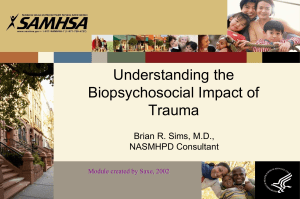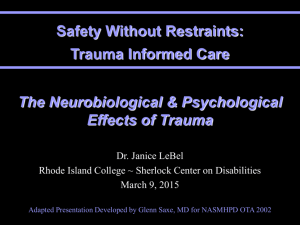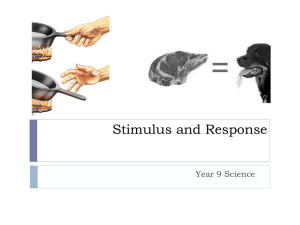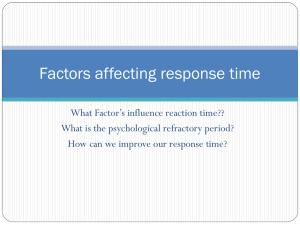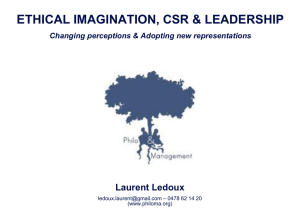Neurobiological and Psychological Effects of Trauma
advertisement
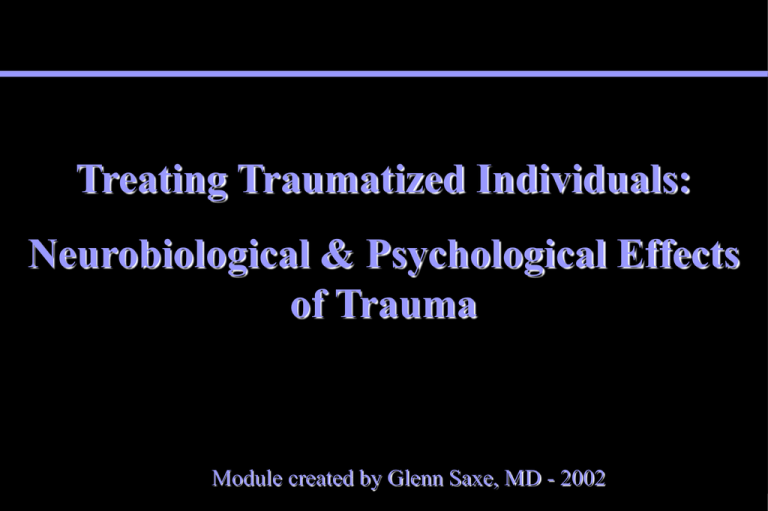
Treating Traumatized Individuals: Neurobiological & Psychological Effects of Trauma Module created by Glenn Saxe, MD - 2002 BU IRTP: Mechanical Restraints FY 2000-2007 (YTD) 120 100 80 Mechanical Restraints 60 40 20 0 2000 2001 2002 2003 2004 2005 2006 2007 BU IRTP: Mechanical Restraints FY 2000-2007 (YTD) 120 100 80 Mechanical Restraints 60 40 20 0 2000 2001 2002 2003 2004 2005 2006 2007 80 Boston Medical Center Intensive Residential Treatment Program Total Restraint & Injury Episodes 09/00 - 06/06 70 BUIRTP Restraint & Injury Episodes 60 Kid Injry Staff Injry 50 40 30 20 10 S ep -0 Ja 0 n0 M 1 ay -0 S 1 ep -0 Ja 1 n0 M 2 ay -0 S 2 ep -0 Ja 2 n0 M 3 ay -0 S 3 ep -0 Ja 3 n0 M 4 ay -0 S 4 ep -0 Ja 4 n0 M 5 ay -0 S 5 ep -0 Ja 5 n0 M 6 ay -0 6 0 Significant Periods Longitudinal Course of PTSD Symptoms in Children with Burns 50 45 40 PTSD-RI Score 35 30 25 20 15 10 5 0 Acute Assessment 3 Month Assessment Time Period Lateral Ventricles Measures in an 11 Year Old Maltreated Male with Chronic PTSD, Compared with a Healthy, Non-Maltreated Matched Control (De Bellis et al., 1999) From Neurons to Neighborhoods: The Science of Early Child Development Report from the Institute of Medicine/National Academies National Research Council Trauma in U.S.A. • 3 million children were suspected of being victims of abuse and/or neglect (Mazelis, 1999) • 3.9 million adolescents have been victims of serious physical assault, and almost 9 million have witnessed an act of serious violence (Kilpatrick et al., 2001) • In 1998, 92% of incarcerated girls reported sexual, physical or severe emotional abuse in childhood (Acoca & Dedel, 1998) PTSD in U.S.A. • Over 50% of U.S. women & 60% of men report experiencing at least 1 traumatic event at some point in their lives. But, only a minority (10% of women & 5% of men) report developing posttraumatic stress disorder, the most prominent psychiatric disorder associated with traumatic events. (Koenen, 2005; Kessler et al., 1995). • More than 80% of those diagnosed with PTSD will suffer from other psychiatric disorders. (Solomon & Davidson, 1997) • For more than 1/3 with PTSD, it will be a persistent condition and experienced for several years (Solomon & Davidson, 1997) Trauma & PTSD in Australia Findings of the 1997 National Survey of Mental Health & Wellbeing indicate: • 57% of the population report a lifetime experience of a specified trauma • Men were more likely to experience most & multiple traumas (except sexual assaults) • The prevalence of PTSD • Overall in the adult population = 1.5% • PTSD prevalence in women = 3.8% • 2.8% of those exposed to trauma develop PTSD (Rosenman, 2002) Effective Treatment Must Account For: 1) A dysregulated nervous system 2) A social-environment that cannot contain this dysregulation Core Concepts of Development 1) The development of children unfolds along individual pathways whose trajectories are characterized by continuities and discontinuities, as well as by a series of significant transitions. (Shonkoff & Phillips, 2000) Longitudinal Course of PTSD Symptoms in Children with Burns 50 45 40 PTSD-RI Score 35 30 25 20 15 10 5 0 Acute Assessment 3 Month Assessment Time Period 309.81 PTSD Definition The development of characteristic symptoms, following exposure to a traumatic stressor involving direct personal experience or witnessing another persons’ experience of: – Actual or threatened death – Actual or threatened serious injury – Threat to physical integrity Post Traumatic Stress Disorder • Characterized by: – Re-experiencing the event • Intrusive thoughts, nightmares, or flashbacks that recollect traumatic images and memories – Avoidance and emotional numbing • Flattening of affect, detachment from others, loss of interest, lack of motivation, and constant avoidance of any activity, place, person, or event associated with the traumatic experience Core Concepts of Development 2) The growth of self regulation is a cornerstone of early development that cuts across all behavioral domains. (Shonkoff & Phillips, 2000) State Change 22 year-old man with history of childhood physical abuse displayed aggressive behavior on psychiatric unit and was physically restrained. State Change 12 year-old sexually abused girl in school when provoked by older male peer. Parameters that change between state •Affect •Thought •Behavior •Sense-of-self •Consciousness Emotional States and Child Development • Discrete behavioral states are a central organizing experience of infancy • Infants experiential world is divided into separate and definable emotional/behavioral states • Critical task of early child development is to build smooth transitions/bridges between states • Regulation of emotion is initially contingent on caregivers facilitating these transitions. (Wolff, 1987) Goal of Treatment • Maintain Calm/Continuous/ Engaged State • Prevent Discontinuous States • Build Cognitive Structures that allow Choices Between Stimulus and Response Stimulus Response Between Stimulus and Response Stimulus Traumatic Reminder Response Socialenvironmental intervention Traumatic State Neuroregulatory Intervention Intervention Between Stimulus and Response Stimulus Traumatic Reminder COGNITION!!! Response Traumatic State Socialenvironmental Intervention Intervention Neuroregulatory Intervention Core Concepts of Development 3) Human development is shaped by a dynamic and continuous interplay between biology and experience. (Shonkoff & Phillips, 2000) Emotional Brain (Restak, 1988) Between Stimulus and Response S Stimulus (LeDoux, 1996) Between Stimulus and Response Sensory Thalamus S Stimulus (LeDoux, 1996) Between Stimulus and Response Very Fast Sensory Thalamus Amygdala S Stimulus (LeDoux, 1996) Between Stimulus and Response Cortex Hippocampus Sensory Thalamus Very Fast Slower Amygdala S Stimulus (LeDoux, 1996) Between Stimulus and Response Cortex Hippocampus Sensory Thalamus Very Fast Slower Amygdala S Stimulus Response (LeDoux, 1996) Between Stimulus and Response Cortex Hippocampus Sensory Thalamus Very Fast Slower Amygdala S Stimulus Response (LeDoux, 1996) Between Stimulus and Response Cortex Hippocampus Sensory Thalamus Very Fast Slower Amygdala S Stimulus Response (LeDoux, 1996) Between Stimulus and Response Cortex Hippocampus Sensory Thalamus Very Fast Slower Amygdala S Stimulus Response (LeDoux, 1996) Between Stimulus and Response Cortex Hippocampus Sensory Thalamus Very Fast Slower Amygdala S Stimulus Response (LeDoux, 1996) Between Stimulus and Response Social Environmental Intervention Cortex Hippocampus Sensory Thalamus Very Fast Psychotherapy Neuroregulatory Intervention Psychopharmacology Slower Amygdala S Stimulus Response (LeDoux, 1996) Rauch Brain scans Play (Panksepp, 1998) Play and Fear (Panksepp, 1998) Social-Ecological Model Culture Neighborhood School Peer Group Family Individual Individual Core Concepts of Development 4) Human relationships, and the effects of relationships on relationships, are the building blocks of healthy development. (Shonkoff & Phillips, 2000) Attachment • Earliest relationships critical for capacity to regulate state • Early traumatic relationships set up person to respond with state dysregulation to interpersonal cues in subsequent relationships Attachment & Relational Deficits •Appear guarded & anxious •Difficult to re-direct, reject support •Highly emotionally reactive •Hold on to grievances •Do not take responsibility for behavior •Make the same mistakes over and over •Repetition compulsion / traumatic re-enactment (Hodas, 2004) Traumatic Relationships • Emotions expressed in interpersonal relationships can be extremely painful and can be related to trauma experience • These trauma-based emotions (e.g. anger, fear, hopelessness, sexual arousal) can be very hard for clinicians to tolerate • Clinicians must be mindful about their experience of trauma-based emotion so that this emotion is not enacted in the clinical relationship Core Concepts of Development 5) Children are active participants in their own development, reflecting the intrinsic human drive to explore and master one’s environment. (Shonkoff & Phillips, 2000) Traumatic Mastery • Many children have primarily experienced abusive and neglectful relationships • Extreme behaviors within relationships can be seen as defensive or self-protective • Traumatized children respond to their trauma history in the present. They are not able to discern that the context has changed • This behavior must be seen as an attempt to master extremely difficult environments. In this way, traumatized children are “doing the best that they can” Core Concepts of Development 6) The course of development can be altered…by effective interventions that change the balance between risk and protection, thereby shifting the odds in favor of more adaptive outcomes. (Shonkoff & Phillips, 2000) TAKE HOME IDEAS • Set up calm and nurturing environments • Teach staff to meticulously observe for ‘triggers’ – when someone is beginning to move from a calm, continuous state to a discreet state of emergency • Train to caring and compassion • Meticulously interview for triggers • Adjust the environment • Adjust what we do (i.e., look at ourselves and our behaviors and actions as the key for success) • We can work to build that cognitive wedge!
